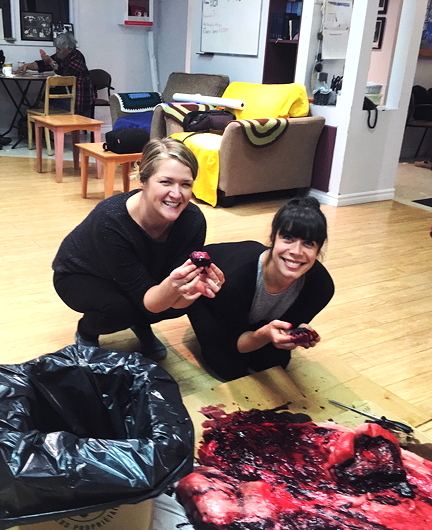Cookbook to showcase intimate Inuit connection to country food
Have you ever glazed your baked char with mayonnaise and onion soup mix? Or used a cup of seal blood to thicken up a hearty stew?
Some Nunavummiut have, and they’ll be sharing these and other recipes and cooking tips from kitchens, campsites and community halls across the territory in a new cookbook currently in the works.
“It’s meant to preserve the traditions and culture around country food,” said Lindsay Anderson, a consultant hired by the Government of Nunavut’s fisheries and sealing division to document how Nunavummiut eat their seal, turbot and char.
That’s why the book will cover much more than simple ingredients.

“Stories about food are just as important as a recipe,” Anderson said. “When people get talking about the food that they love, recipes come out … when they talk about their favourite way to prepare things or eat things.”
The fisheries and sealing division recently put a call out for recipes from across Nunavut. Another call for recipes will be issued in January, with the hope of getting submissions from every community or, at the very least, from every region.
In the meantime, Anderson and her co-consultant, Dana Vanveller, have been travelling through the Baffin region to scout out content for the book, snap food photos and taste whatever they can.
The two have already visited Pangnirtung, Clyde River and Iqaluit, and are planning another trip in the springtime.
But it’s not the first time these two women have ventured north in search of a good meal.
In 2013 Anderson and Vanveller spent five months travelling 37,000 kilometres across Canada—including one stop in Nunavut—in pursuit of the stories behind classic Canadian dishes, and to dig up secret recipes in each region of the country.
They documented their trek in a blog, and in a cookbook released in March called Feast: Recipes and Stories From a Canadian Road Trip.
When it came to the territories, food in Nunavut clearly stood out—and that was just from one trip to Rankin Inlet.
“Within a generation or two, people were still living nomadically on the land. You can see it; the emotional ties to food are the most predominant in all of Canada, I think,” Vanveller said.
While in Rankin Inlet, the duo billeted with a staffer who worked in the GN’s fisheries and sealing division. So when the division decided to launch a cookbook project on ways Nunavummiut can prepare seal, turbot and char, they decided to call Vanveller and Anderson.
“This [book] is something that we are hoping will be passed down to generations,” said Jade Owen, a GN spokesperson.
The GN brought Anderson and Vanveller on as consultants, in part because of their experience with grassroots recipe collection, but also because the last time the GN attempted to compile a cookbook through call-outs alone, the division received very little feedback, Owen said.
“This project is still very community-based and community-focused. It’s going to only include contributions from Nunavummiut, for Nunavummiut,” she said.
“One of the main objectives of the fisheries and sealing division is to support a sustainable fishery in Nunavut, as well as the seal hunt and sealing industry. Increasing demand for local fisheries products is one of the ways to do that,” Owen said.
“A cookbook is also a really accessible platform to share stories and recipes that feature seafood from Nunavut waters such as a char and seal and turbot.”
And what will the cookbook look like? Anderson and Vanveller still have to sit down and figure that out.
A model like the Joy of Cooking or even a Jamie Oliver-style cookbook wouldn’t work so well in Nunavut, Anderson said, since many recipes are shared orally and don’t have standard measurements for how much of each ingredient to use.
“It’s a very unique food tradition here so the book itself needs to be unique and to reflect the needs of the people here,” she said.
Making suggestions for substitutions in the recipes might not be possible either, said Vanveller, since many ingredients can only be hunted or gathered in certain seasons and aren’t available in local stores.
“You can’t say, ‘If you don’t have seal, use beef,’” she said.
In fact, Vanveller and Anderson have been trying to avoid the word recipe when they talk to people in communities because it’s a word that can be intimidating or limiting, they said.
“A lot of time people will say, ‘Oh, I don’t have any recipes.’ But then they’ll start telling stories and [giving] descriptions on how to prepare things,” Vanveller said.
Or they’ll tell stories about how they don’t prepare their food, like one Iqaluit hunter who took Anderson and Vanveller out on a seal hunt.
“One of them said, ‘I love to just, right on the boat, when they’ve cut it up, just take a piece, dip it in the water, and in she goes.’ And that’s his favourite way,” she said, meaning raw, and garnished with seawater.
“In the South, there’s a growing movement of ‘how to get back to the land,’ but here it’s just a way of life. People hunt and go out and gather all kinds of things from the tundra,” Anderson said. “That closeness to your food is difficult to find elsewhere.”
If you have a recipe you’d like to see included in the cookbook, you can email the fisheries and sealing division at [email protected] or call Jade Owen at 867-975-7760. Interpretation is available in Inuktitut and Inuinnaqtun.